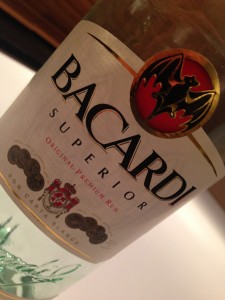Rum: What’s in That Pirate’s Flask?
As the daughter of a sailor, I’ve learned a lot about rum. I know it tastes sweet and it can make a grown man cry or sing (or both) when taken in excess. I’ve also learned that rums are very distinct.
Scientifically speaking, rum is created from fermented fresh sugar cane juice, cane syrup or molasses. The cane juice is made by crushing harvested sugar cane. The juice can be turned into syrup by boiling some of the water content out of it.
In a lot of cases, rum is produced from molasses, which is the dark, gloopy byproduct of the process that refines sugar cane into sugar.
All rums are clear after distillation but gain colour (as well as flavour) as they age. My Diffords Guide hints that all this knowledge might have been gained by accident: “The fact that ageing in oak barrels improved the raw rum was discovered when ships carried rum on the long passage to Europe: it arrived darker in colour and with an enhanced flavour.”
Barcardi Superior rum – known for its clarity – starts out life as sugarcane molasses before it is fermented and distilled several times. It’s later aged inside an oak cask for a year and then charcoal-filtered to remove any colour.
Thankfully this process doesn’t rip out all the flavour. Bacardi Superior is the perfect mixing rum for me. I love the soft hints of vanilla and almond it gives any fruity cocktail.
As a matter of fact, I have a great idea on how to use some of my Bacardi stash tomorrow. Until then!
